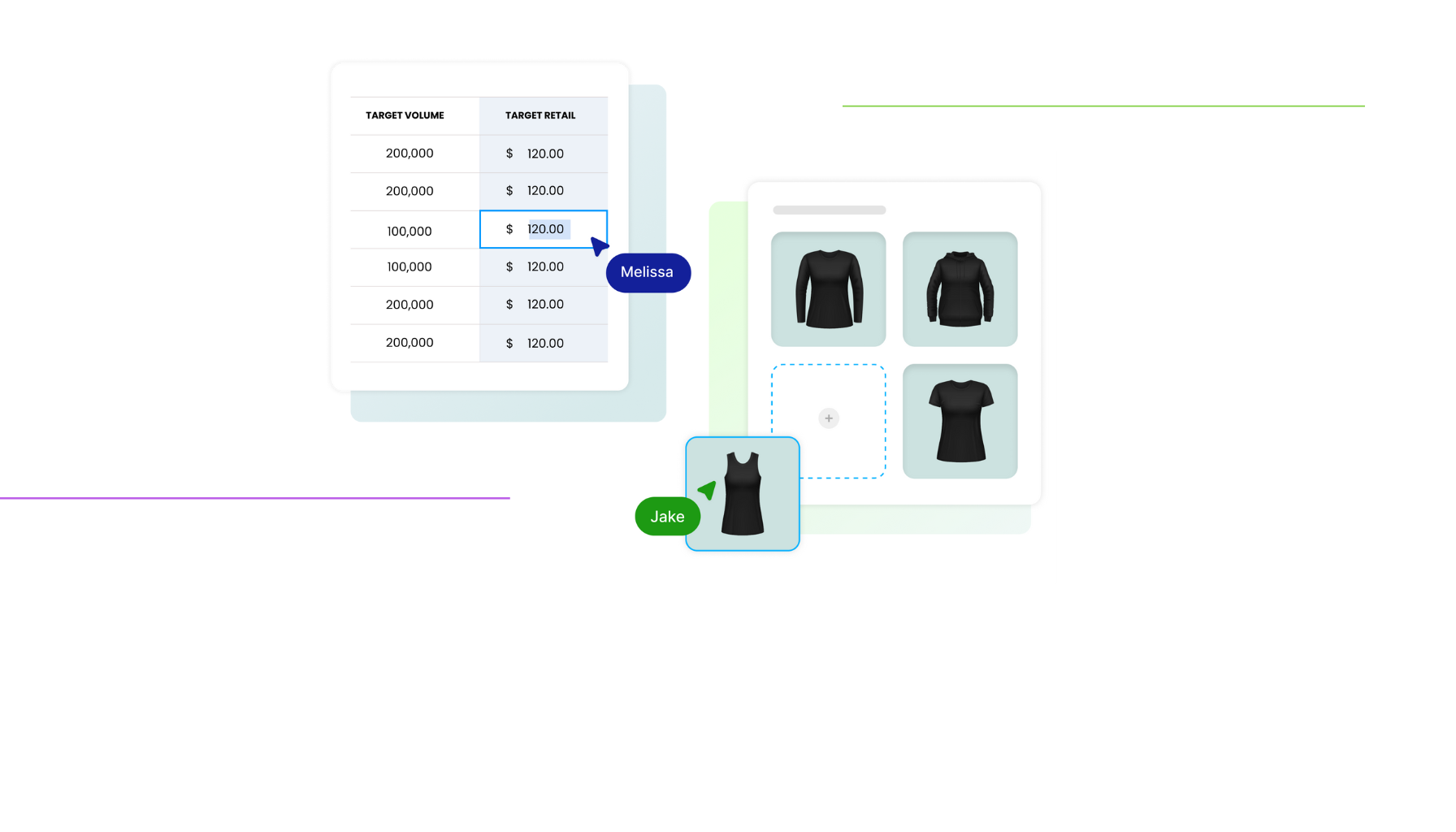This article was first published in The Interline’s PLM Report 2023, as part of a collection of perspectives on the current landscape.
Key Takeaways:
- Digital transformation is a major focus for companies across all industries. One of the biggest challenges of the shift to digital products is providing access for all roles that need those assets to help fuel their decision-making.
- Brands have found themselves increasingly dependent on visual documentation, such as PowerPoint and collaborative, cloud-based whiteboards, to help address this challenge. However, these document-based solutions come with a number of issues, including being time-consuming to create and lacking connectivity with other essential product data systems.
- A better solution is needed that enables brands to produce digital, visual presentations that showcase their product offering, including relevant data from PLM, historical sales from BI, and other structured information needed to make the right decisions.
Digital transformation has become a major focus for companies across all industries in recent years. With the rise of digital technologies, businesses are recognizing the need to invest in new processes and tools that enable them to operate more efficiently, reduce costs, and improve outcomes.
One area of digital transformation that is gaining significant attention is Digital Product Creation (DPC). This refers to the process of creating and managing digital twins of physical products using software tools and workflows. Once they exist, these digital twins can transform the whole go-to-market of a given product. In addition to replacing physical prototypes and samples, the same digital assets can fuel a range of different decision- making processes – all the way up and downstream.
Given the scale of the transformation it entails, and the number of stakeholders it touches, the shift from physical to digital products has created new challenges for brands that they must navigate to stay competitive. While the digital age has enabled brands to create highly detailed and visually stunning digital products, and to use them for a wide spectrum of different purposes, it has also created barriers to accessibility that make it challenging for everyone in the organization to access those digital products and extract value from them for their particular workflows. A digital twin of a garment is only valuable if it can be made available everywhere its physical counterpart might be needed.

One of the biggest challenges brands face, then, is providing access to digital products for all the roles that need them. While DPC tools have made it possible to digitize their full assortment (or whatever slice of it they have chosen to prioritize), interacting with the resulting assets often requires specialized software and skills that are not available to everyone in the organization. This can make it difficult for certain roles, such as merchandising and sales, to access detailed visualizations of products, which they need to make informed decisions.
This is where dead-ends can be created in a digital transformation journey. Valuable data and assets are created, but not universally distributed – limiting their value and leading to exactly the sort of information silo-ing that digital transformation is intended to avoid.
To help address this challenge, brands have found themselves increasingly dependent on visual documentation such as PowerPoint and collaborative, cloud-based whiteboards such as Miro and Mural – taking static shots of 3D garments, shoes, and accessories, and adding them to boards that are designed to capture the visual identity of a product as well as the data behind it.

These document-based solutions, while highly collaborative, accessible and easy to use, come with a number of issues. Each of which has the potential to terminate in yet another data dead-end.
Firstly, the documents are incredibly time-consuming to create, requiring a large amount of manual authoring, hunting for accurate information, and copy & pasting of images. Unlike a live 3D representation of a garment, these snapshots are difficult to assemble, convoluted to share – and they also represent a new collection of data that is not automatically connected to anything else.
Because there is no connection between the tools used for collaboration (sheets, boards, and slides) and the systems that hold essential product data, such as PLM, ERP, DAM, and BI, which could be considered a “single source,” manually authored documents containing product data and imagery will quickly become outdated, rendering them inaccurate.

As a result, any investment in visual presentations is a significant undertaking, and one that has some significant drawbacks when compared to collaboration fueled by a true digital twin. Extracting visual representations and product data from centralized solutions and putting them into disconnected repositories must be done with care, and only once data is relatively stable. Once shared, these documents have a limited shelf life, and often contain out of date information. Unfortunately, this has a significant impact on the agility and accuracy of teams working to bring a product line to market.
Clearly, a better solution is needed. Wider access to embedded 3D visualizations will certainly help, but educating every stakeholder on how to use and get the most out of digital assets is not likely to be a practical solution.
Ideally, brands would have a platform that enables them to quickly produce digital, visual presentations that showcase their product offering, including relevant data from PLM, historical sales from BI, and other structured information needed to make the right decisions – all of which would remain connected to the centralized source of information that underpins it all. All the visibility and collaboration, with none of the data dead-ends.

These presentations would be able to leverage either 2D or 3D representations of products, without requiring special technology or training. Viewing 3D models would not require any sort of proprietary software, and the file sizes would be optimized for quick download & global accessibility.
Unlike the documents we know today, this new solution would have the ability to integrate with key enterprise systems, so that as new data is created, or existing data is updated, it is reflected in all relevant presentations. When presentations are shared with stakeholders, the information would be up to date and trustworthy, greatly impacting the accuracy of decisions made.
With this new form of collaborative visualization solution, roles such as sales and merchandising would be able to seamlessly participate in a digital workflow, despite not being closely connected to the DPC process itself.
Fortunately, a solution like this does exist.
Based on the challenges described above, the team at VibeIQ has developed a suite of collaborative productivity apps specifically made for companies that design, manufacture or sell products.

Unlike traditional documents, sheets, slides, and whiteboards, VibeIQ’s Plan, Showcase, Board, and Showroom applications maintain associativity with your product’s digital assets and related product data.
VibeIQ’s cloud-based Software-as-a-Service (SaaS) platform has the ability to manage product data and digital assets directly or seamlessly integrate with your existing enterprise systems such as digital asset management (DAM), product lifecycle management (PLM), and other key enterprise systems.
Over the past several years, brands who have deployed VibeIQ’s applications have progressed towards their digital transformation goals by making their digital product assets and related business data available to the roles who most need that information. Product based workflows such as line planning, milestone reviews, channel adoption, vendor collaboration, and sell-in have been optimized by ensuring accuracy, reducing effort, and enabling iterative feedback loops.

Overall, the shift to digital product creation is presenting new challenges and opportunities for brands across all industries – but especially for fashion and footwear, where complex product mixes, long timelines, and difficult trend forecasting conspire to make the go-to-market process uniquely difficult.
By leveraging solutions like VibeIQ, brands can unlock the full potential of DPC and realize the benefits of digital transformation, without running the risk of leaving behind other departments, colleagues, and partners who also stand to benefit from the value of that new way of working. These benefits include increased agility, reduced costs, and improved outcomes, as well as new opportunities for innovation and growth.
As the importance of digital transformation continues to grow, it is likely that we will see increasing investment in DPC and other digital workflows. This investment will be critical for companies looking to remain competitive in an increasingly digital world, and provided they take care to avoid data dead-ends, this journey will enable them to unlock new opportunities for innovation and growth.

The entire report (Vibe IQ featured on pages 43-47)

Brian Lindauer is an executive leader possessing combination of product strategy, product management, and deep technical software development experience. He has held product leadership roles in both small start up and large company environments, crafting strategy & leading technology development for both on- premise and cloud based offerings.


